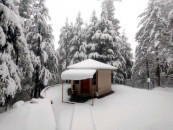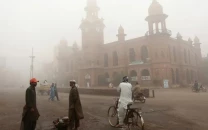Ancient inn: Museums dept plans conservation work at Rawat Fort
People often pull out bricks from relic that witnessed battles between Gakhars and Sher Shah Suri

PHOTO: EXPRESS
Preservation of cultural heritage and archaeological sites not only relives a nation but also promotes rich cultural heritage of the country and tourism, bringing monetary benefits to the country.
Rawat Fort is originally an ancient sarai (inn) situated about 11 miles from Rawalpindi towards Jhelum close to the Grand Trunk road and appears to have been built during the Sultanate period in early 15th century. "The department has started conservation work mainly to preserve the fort with damaged boundary walls, 19 rooms, three-domed altered mosque, crumbling graves and a deserted mausoleum after approval of PC-I for repair, maintenance and development of Rawat Fort with the cost of Rs28 million," an official of DoAM said.
The biggest problem was of the encroachments from three sides of the fort, which is sheer violation of the Capital Development Authority (CDA) law that prohibits construction within 200 feet of the historical monuments premises.
The issue has not been resolved yet despite writing to the authorities in CDA for several times to remove encroachments at the fort site, the official revealed.
However, the conservation of the fort will at least help protect this ancient site from further ruining as well as stop the drug addicts and beggar residing there through repair of boundary walls, the official said.
Rawat Fort had 45 rooms, out of which 19 still exist and others have fallen prey to vandalism of people who have stolen the bricks to make their houses. These rooms once housed weary travellers of ancient era.
According to the description board outside the fort with half omitted words, the fort is associated with the name of Masud, son of famous Mehmood of Ghaznavi in 1039 where he was overpowered by his mutinying soldiers and eventually murdered in the Fort of Giri near Taxila.
The fort is also associated with the name of Ghakhar tribe chief Sarang Khan who fell with his 16 sons fighting against Sher Shah Suri and buried within the precinct of this monument, it says.
The locals altered the historical mosque and the mausoleum of Sarang Khan in the fort from their original architecture, violating the law that prohibits damaging or altering the historical monuments.
The graves of 16 sons of Sarang Khan and others are also in dilapidated condition as usually locals pull the bricks of these graves out when they need it.
DoAM, Islamabad protected this site under Antiquities Act 1975 but after devolution under 18th amendment of the constitution, Punjab government acquired it.
The department again acquired the site and started initial working on a plan for its maintenance and preservation. DoAM purchased the road linking the historical site with Grand Trunk Road but shopkeepers and roadside hawkers have encroached upon it.
According to historical facts, the fort was founded as a caravanserai in the 15th century by the Sultans of Dehli, though the caravan itself may have been built atop a Ghaznavid-era fort that was established in 1036.
The caravanserai was then later fortified in the 16th century by the local Gakhar – warrior clans loyal to the Mughal emperor Humayun in order to defend the Pothohar plateau from Sher Shah Suri's forces. The fort was the scene of a battle between the Gakhar chief Sultan Sarang and Afghan king Sher Shah Suri in 1546.[5] Sarang was captured, tortured at the fort by the forces of Sher Shah Suri, and then buried at the fort.
Published in The Express Tribune, July 27th, 2018.


















COMMENTS
Comments are moderated and generally will be posted if they are on-topic and not abusive.
For more information, please see our Comments FAQ